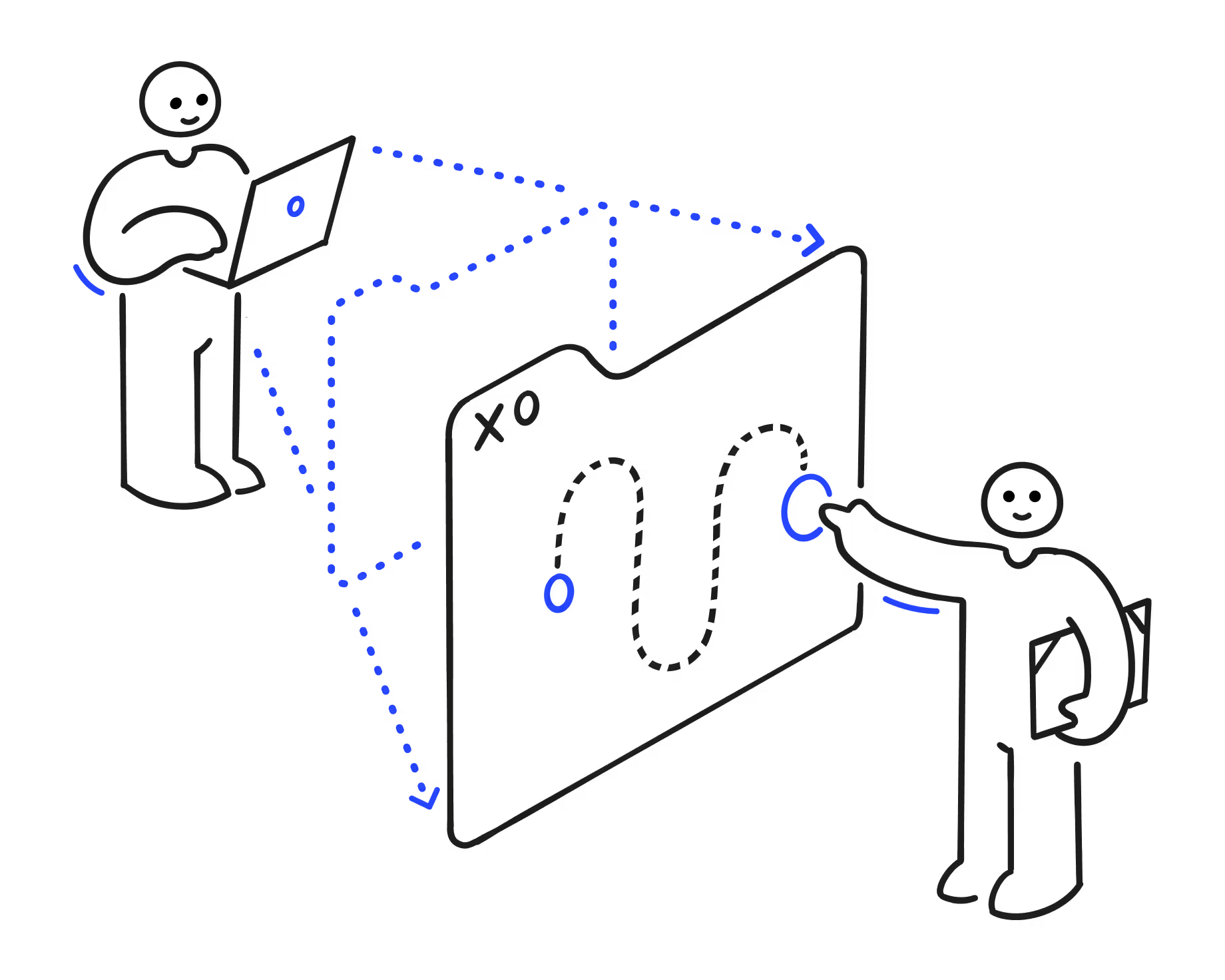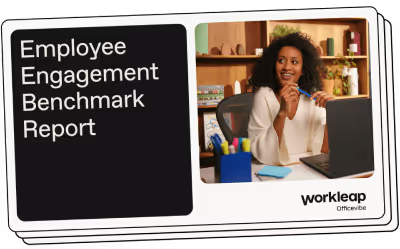Building growth opportunities with career pathing frameworks

Discover Workleap Officevibe's benchmark report on 12 key employee engagement metrics

Talented workers won’t stay with a company if they can’t see a future there. They need a clear frame of reference for the opportunities available to them. Career pathing frameworks provide that.
This article shows why career pathing frameworks matter to both employees and business success, details how to build them, and presents best practices to ensure success.
What is a career pathing framework?
Career pathing frameworks, also known as career progression frameworks, are a map of a department’s roles and advancement opportunities. They identify the different positions available and describe the necessary prerequisite skills and experience required to hold them.
Using these frameworks, employees can plot out their future on a team or at a company. They’ll understand the progression and which skills they need to develop for advancement. For example, a junior account executive can look at a career pathing framework and see that the next step is account executive, followed by senior account executive, and then account manager.
Career pathing frameworks are also a part of the succession planning process. Identifying each role and its requirements helps build targeted development programs. Employers can rest easy knowing that, when a current employee departs, another individual is ready to take over.
Why do businesses use career pathing?
Career pathing facilitates employee growth by defining which skills and professional experiences really matter. When people understand how to advance their careers, they’re motivated to work hard to meet those requirements. This boosts retention and engagement.
From a business perspective, providing internal progression routes decreases hiring costs and supports succession planning. Promoting an employee rather than hiring externally also reduces onboarding time, boosting productivity levels. Plus, employees move into more senior roles with an existing understanding of how teams operate and what the company expects.
How to build a career pathing framework: step-by-step
A career pathing framework should be a structured map of a department’s roles, outlining key responsibilities and skill requirements.
To build one effectively, follow these five steps.
Step 1. Define job levels and roles with clear responsibilities and required competencies
Begin by charting the roles, responsibilities, and skills for each position in the department. Be sure to explain what distinguishes each job title from the others. What makes a senior account manager different from a junior account manager? The answer should be clear to anyone reading.
Step 2. Include different career progression paths
Career progression isn’t necessarily linear. An employee may move to a different department or take on new responsibilities without their role changing.
Evaluate whether these career path strategy tracks need to be part of the framework:
- Vertical: Promotions are the most typical form of career path progression. They include moving from a junior to a mid-level role, or advancement to manager.
- Lateral: Lateral career movement is when a worker moves to a different position at the same level. They might be interested in a role that better suits their interests or skills on another team or in a whole new department.
- Role expansion: An employee might take on additional responsibilities without their job title changing. Role expansion can be a valuable form of development with less disruption to a team’s current operations.
Step 3. Identify skills and competencies
Advancement to a more senior position or moving to a new department often requires the employee to learn and develop new skills. After mapping a department’s roles, include any necessary experience, skills, or qualifications.
Each role should be cumulative: More senior positions should include all the requirements of roles below them. If one competency is particularly important, such as accreditation for an accounting role, make sure to highlight this.
Step 4. Communicate transparently
Laying out a role and its requirements is helpful, but if employees don’t understand how to get there, then the exercise was pointless. When building a career pathing framework, take extra care to emphasize how to meet these requirements. Highlight any learning and development (L&D) tools at employees’ disposal to better meet these development milestones.
Full transparency allows employees to better understand internal mobility, motivating them to take part in the process.
Step 5. Set measurable performance metrics
By monitoring performance, companies can identify when an employee has met a role’s requirements and is ready to progress. Supplement a career pathing framework with regular performance reviews to establish competency levels. This will also make it easier to identify the kinds of support ambitious employees require for greater success.
Workleap Performance offers data-first insight into skills and productivity, helping identify employees who are ready for promotion.
Career pathing best practices
Here are a few best practices to help make career pathing efforts more effective.
Align career development with organizational goals
Map required skills and experiences to organizational requirements. Alignment between organizational needs and career development efforts ensures that employee growth directly supports future business objectives.
Provide ongoing learning and mentorship opportunities
Offering structured L&D opportunities gives employees the chance to develop the exact skills they need for internal mobility. Managers can identify which areas an employee should focus on and use the framework to highlight potential progression opportunities.
Workleap Performance streamlines these conversations by facilitating 360 feedback and providing real-time insights into employee skills and performance. Managers can use Workleap to identify key areas for improvement automatically and offer structured advice.
Use HR software to track progress
HR software simplifies the data collection and feedback gathering processes, allowing businesses to more effectively track and measure employee growth.
Workleap’s platforms support career pathing frameworks, providing AI-powered analytics and insights that measure growth and identify when employees are ready to progress.
Leverage employee feedback and regularly revisit frameworks
As you develop career paths for employees, collect feedback to assess how accurate each framework is. Employees at each level may have insights into whether the listed responsibilities align with their day-to-day experiences.
Regularly revisit frameworks and use gathered feedback to identify any areas for improvement. For example, a role’s demands may have shifted in response to recent industry developments. Ongoing updates ensure frameworks remain accurate, relevant, and aligned with evolving organizational priorities.
Workleap Officevibe empowers your HR teams, helping them rapidly gather feedback from employees with pulse surveys. The insights from these questionnaires can help ensure career pathing frameworks are accurate and teams are aligned.
Career pathing examples
Career pathing frameworks will look different depending on the industry, business, and even department.
Here are a few examples of career path models.
Customer support agent progression
This is a high-level example of a career progression framework for a junior customer support agent:
- Senior support agent: To progress from junior to senior support agent, employees will require extensive troubleshooting skills, advanced product knowledge, and excellent customer communication skills.
- CS team lead: To advance to team leader, senior support agents must exhibit leadership skills, suggest workflow optimization ideas, and coach fellow agents on internal docs.
- Customer experience manager: To work as a manager, employees need to demonstrate development of customer experience enhancement strategies, advanced data-management skills, and leadership abilities for cross-team programs.
Software developer progression
Here is the sample career progression framework for a junior software developer:
- Mid-level developer: To reach this level, candidates need to display high competency in related coding languages, understand internal models, and collaborate with teammates effectively.
- Senior developer: At this level, developers need advanced knowledge of multiple coding languages, must exhibit leadership qualities, and need to be able to mentor junior staff.
- Software solutions architect: At the highest levels, employees must be able to spearhead scalable software solutions, inform technical strategy, and collaborate with department leads to meet organizational goals.
Setting up employee growth with career pathing frameworks
Career pathing frameworks offer clear routes through an organization, fostering engagement and driving loyalty. Alongside providing transparency, these frameworks help companies meet organizational objectives by motivating employees to hone their skills and progress.
With Workleap Officevibe, managers and HR teams can track employee sentiment around growth and development opportunities, and refine career pathing efforts. Using Workleap’s feedback and recognition tools, you can also reinforce positive employee progress and keep employees energized.
Request a demo today and discover how Workleap’s data-driven insights can help you craft winning career planning frameworks.
FAQs
What is the difference between career pathing and career mapping?
Employee career mapping identifies all the potential routes an employee could take through an organization. Career pathing is the process of crafting a framework that identifies the responsibilities of each role, their skill and experience requirements, and how to move down that path.
What are the 4 types of career paths?
The four career paths are vertical, lateral, role expansion, and dual career paths. The first three are explained above, but a dual career path is when there are two progression routes for an employee to choose from. The choice is typically between a people-management position and a more technical, specialized role.
What can companies do to improve career pathing?
Regularly asking for employee feedback is the most effective way of identifying issues with the career pathing process. Use tools such as Workleap Officevibe’s pulse surveys to ask whether teams are clear on any available progression options. Use this feedback to update job roles and expectations regularly.
What is the first step in career planning?
The first step in career planning is to identify every job role in a department. From here, highlight the demands and responsibilities of each position, and any required skills, certifications, or experience.
Employee Engagement Benchmark Report
How do you stack up?


%20(1).avif)


.avif)
.avif)






.avif)
